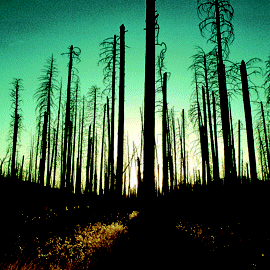May 22, 2006
Whatever Happened to Acid Rain?
By Michael D. Shaw
Good question. You don’t hear a lot about it these days. Acid rain was THE most talked about environmental scourge of the 1980’s, although, in truth, acid precipitation has been known for centuries, as it was historically most readily connected with the burning of coal, plaguing cities such as London.
Acid rain develops when sulfur dioxide (SO2) and nitrogen oxides (NOx) react in the atmosphere with water, oxygen, and other atmospheric chemicals. The SO2 and NOx derive from combustion of fossil fuels, various industrial processes, and even certain natural biological reactions. Sunlight acts as a catalyst, and the result is a mild solution of sulfuric acid and nitric acid.
The degree of acidity is measured on a scale called “pH”, defined as the negative logarithm of the hydrogen ion concentration, operating in a range of 0 to 14. Pure water has a pH of 7.0, and the lower the pH, the more acidic the solution. In the 1980’s, in the time period between the era of the recognition of environmental hazards, but before much was actually done about it, pH levels as low as 2 were measured in the eastern US and western Europe.
To put the pH numbers in perspective, note that normal rain is slightly acidic because atmospheric carbon dioxide dissolves in it, yielding a pH of about 5.5.
One major effect of acid precipitation is damage to aquatic life via both acidifying the water per se, and the leaching of toxic aluminum from surrounding soils. Damage to vegetation and agriculture also occurs, as well as corrosion of man-made structures.
So, what is being done to improve the situation?
First of all, since the 1980’s, numerous regulations have come into effect forcing polluting facilities and automobiles to produce far less emissions. Cleaner fuels are being utilized along with all sorts of pollution control and reduction technologies. Undeniable progress can be observed compared to the bad old days, and many commentators view EPA’s Acid Rain Program as a success, yet more can and must be done.
While emissions reduction technology is getting better all the time, acid rain will not disappear until we stop using fossil fuels, and that day seems far off. Still, we should move more aggressively into alternative energy sources, such as nuclear, hydro, geothermal, and the elusive “hydrogen economy.” Conventional nuclear and hydro show the most promise for larger scale use, and development should be encouraged.
Indeed, the promise of hydrogen—the most abundant element on Earth—requires great amounts of energy to unlock its use, and the best way to crack it will be nuclear fission.
At this point, wind and solar are appealing because they are clean, but must be considered only supplemental, not primary sources. Of course, the greatest dream of all is nuclear fusion, the energy source of the stars. Simply put, commercial fusion-power stations would provide an inexhaustible source of electricity, with no pollution. This is not an impossibility, but so far, achieving practical fusion has stumped some of the most brilliant minds on the planet.
As to remediation of already damaged areas, time is the best healer, but you are talking decades or even longer.
Norway and Sweden have had limited success with the so-called “liming” process, whereby naturally alkaline (opposite of acidic) limestone is placed into affected lakes to neutralize the excess acidity. Even though lime is relatively cheap, the logistics of the process can make it expensive, and treatment has to be repeated.
The primary application of liming has been to restore these bodies of water to allow fish populations to build up, helping the local natives (mostly Laplanders) continue their subsistence way of life. This is only justice, since these same innocents were drastically affected by polluting processes they had nothing to do with, and that benefited them little or not at all.
Whatever happened to acid rain? It’s still with us, but not as virulent, and improvement is ongoing.

